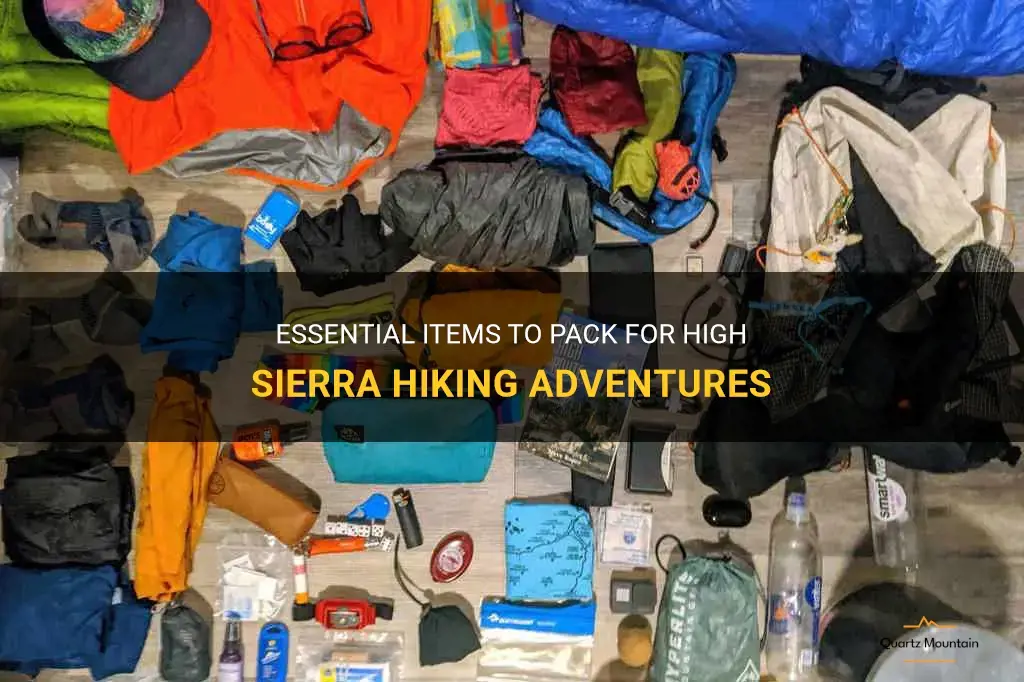
Embarking on a high Sierra hiking adventure can be a thrilling and memorable experience. But amidst the breathtaking views and challenging terrain, it's essential to be well-prepared and equipped for the journey. From sturdy hiking boots to solar chargers, this article will highlight the essential items to pack for a successful and enjoyable high Sierra hiking adventure. So lace up your boots, grab your backpack, and get ready for an unforgettable expedition into the wild beauty of the High Sierra mountains!
What You'll Learn
- What essential items should be included in a backpack for a high sierra hike?
- How should I dress for a high sierra hike to ensure comfort and safety?
- Are there any specific gear or equipment recommendations for high sierra hiking?
- What types of snacks and meals are recommended for high sierra hikes to ensure energy and nutrition?
- Are there any additional items or considerations that should be taken into account when packing for a high sierra hike, such as weather conditions or wildlife encounters?

What essential items should be included in a backpack for a high sierra hike?
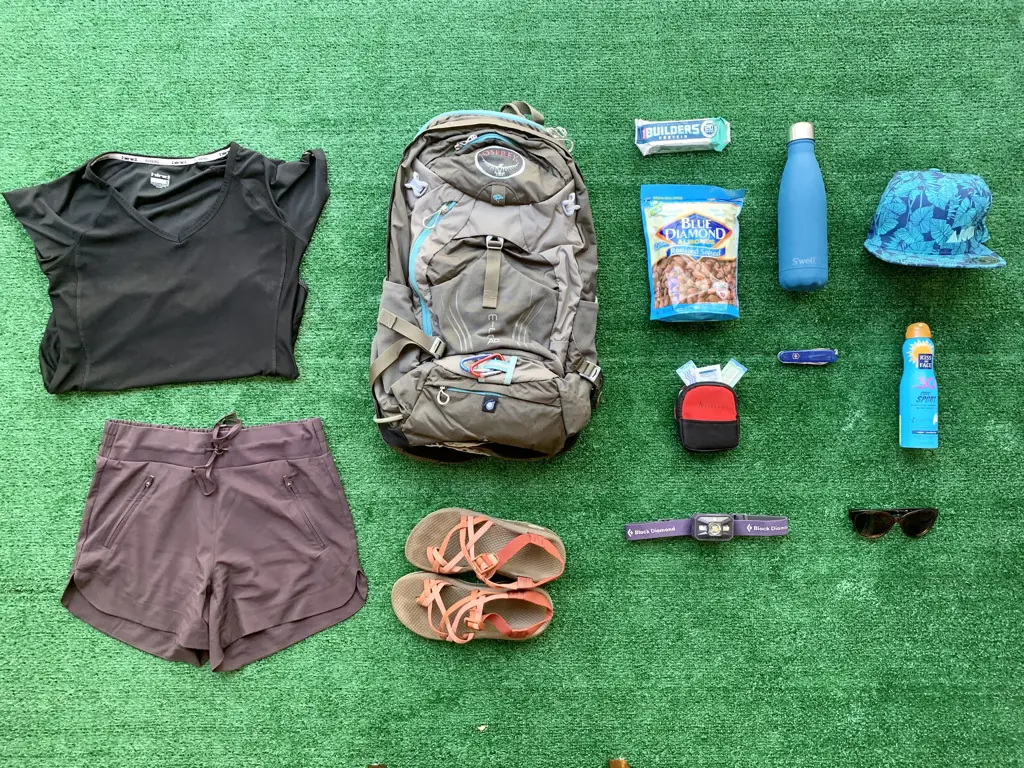
When preparing for a high Sierra hike, it is crucial to pack a backpack with essential items to ensure a safe and enjoyable trip. The high Sierra region offers stunning landscapes and challenging terrain, so being well-prepared is essential. Whether you are hiking for a few days or a week, there are certain items that should always be included in your backpack. Here are some essential items to consider:
Navigation Tools:
Having a reliable map and compass is crucial when hiking in the high Sierra. Trails can be challenging to follow, and it is easy to get disoriented. Supplementing your map and compass with a GPS device can also be helpful, but it should not be relied upon as the sole means of navigation.
Adequate Clothing:
The weather in the high Sierra can be unpredictable, so it is essential to pack clothing that can withstand changing conditions. Layering is key, as it allows you to adjust your clothing to match the temperature and activity level. A waterproof and breathable jacket, along with sturdy hiking boots, should also be included to protect against rain and ensure traction on rocky terrain.
Shelter:
Carrying a lightweight tent or bivy sack is essential for overnight hikes in the high Sierra. While not always necessary, having a shelter can provide protection from unexpected weather changes or emergencies. Additionally, a sleeping bag and sleeping pad are crucial for a comfortable night's rest.
Food and Water:
Pack enough food to sustain you throughout your entire trip. Plan for calorie-dense foods such as energy bars, nuts, and dehydrated meals that are lightweight and easy to prepare. In the high Sierra, water can be scarce, so it is crucial to carry enough water or have a water filtration system to purify water from natural sources.
First Aid Kit:
Accidents and injuries can happen, so always bring a well-equipped first aid kit. Include items such as bandages, antiseptic ointment, pain relievers, and any necessary prescription medications. Also, be sure to carry a basic knowledge of first aid procedures or take a course before your hike.
Emergency Communication:
While cell phone coverage may not be available in remote areas, it is essential to carry a reliable means of emergency communication. A handheld two-way radio or a Personal Locator Beacon (PLB) can help you summon help in case of an emergency.
Lighting:
Carrying a lightweight headlamp or flashlight with extra batteries is essential for nighttime navigation and emergencies. In the high Sierra, it can get dark quickly, and having a reliable light source is crucial.
Tools and Repair Kit:
A multi-tool, a repair kit, and duct tape prove to be invaluable in the backcountry. These items can assist in gear repairs, improvising solutions, or handling unexpected situations.
Sun Protection:
The high altitude of the Sierra means intense sun exposure. Always wear sunscreen, sunglasses, and a hat to protect yourself from harmful UV rays.
Leave No Trace Principles:
Lastly, it is crucial to practice Leave No Trace principles when hiking in the high Sierra. Pack out all trash, including food scraps, and only camp in designated areas to protect the fragile ecosystem.
By packing these essential items, you will be well-prepared for your high Sierra hike. Remember to also check the weather forecast, inform someone of your planned route, and be aware of your physical limitations. With proper preparation and the right gear, you can have a safe and memorable experience in the high Sierra.
Essential Items to Pack for Your Trip to Cambodia
You may want to see also

How should I dress for a high sierra hike to ensure comfort and safety?
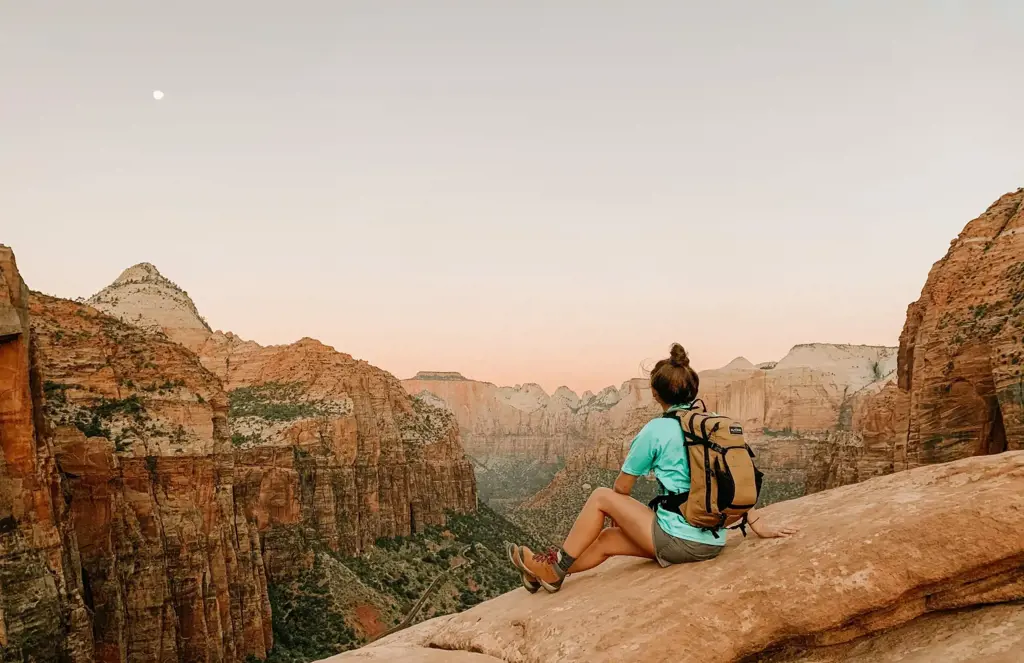
When embarking on a high Sierra hike, it is essential to dress appropriately to ensure your comfort and safety. The Sierra Nevada mountain range offers breathtaking views, but the weather conditions can be unpredictable and challenging. To make the most of your hike, follow these guide on how to dress for a high Sierra hike:
Layering is Key:
The weather in the Sierra Nevada can vary greatly throughout the day. Mornings and evenings can be chilly, while the midday sun can be scorching. Dressing in layers allows you to adjust your clothing according to the changing temperatures. Start with a moisture-wicking base layer to keep sweat away from your body. Merino wool or synthetic materials are excellent choices. Add a insulating middle layer, such as a fleece or down jacket, to keep warm when it's cold. Lastly, wear a waterproof and breathable outer shell to protect yourself from rain and wind.
Choose the Right Fabrics:
Cotton should be avoided when hiking in the high Sierra. Cotton absorbs moisture and takes a long time to dry, which can make you feel cold and uncomfortable. Opt for quick-drying and moisture-wicking fabrics that help regulate your body temperature. Merino wool, polyester, and nylon are excellent choices as they are lightweight, dry quickly, and offer good insulation.
Protect Your Extremities:
Hiking in the high Sierra means exposure to intense sunlight and potentially freezing temperatures. To protect your skin, wear a wide-brimmed hat that shades your face, neck, and ears from the sun. Sunglasses with UV protection are also a must. It's essential to wear sturdy, well-fitting hiking boots that offer ankle support and have grippy soles. Invest in good hiking socks made from merino wool or synthetic materials to keep your feet dry and blister-free. Finally, bring lightweight gloves to keep your hands warm during colder parts of the day.
Don't Forget Rain Gear:
Even in the summertime, thunderstorms and showers can occur in the Sierra Nevada. A sudden change in weather can make hiking dangerous, especially if you are unprepared. To protect yourself from rain, always carry a lightweight, packable rain jacket and rain pants. These garments should be waterproof and breathable to keep you dry without causing excessive sweating.
Be Prepared for Cold Nights:
As you ascend to higher altitudes, the temperatures can drop significantly, even during the summer months. Consider packing a lightweight, compressible down jacket or a thermal layer to wear at camp or during breaks. Wearing a hat and thermal leggings can also help retain body heat. Always check the weather forecast before your hike and pack accordingly.
By following these tips, you can ensure your comfort and safety during a high Sierra hike. Remember to be prepared for changing weather conditions and pack extra layers in case of unexpected temperature drops. Dressing appropriately allows you to fully enjoy the beauty of the Sierra Nevada while keeping you safe on your adventure.
Essential Items to Pack for Navy Boot Camp
You may want to see also

Are there any specific gear or equipment recommendations for high sierra hiking?
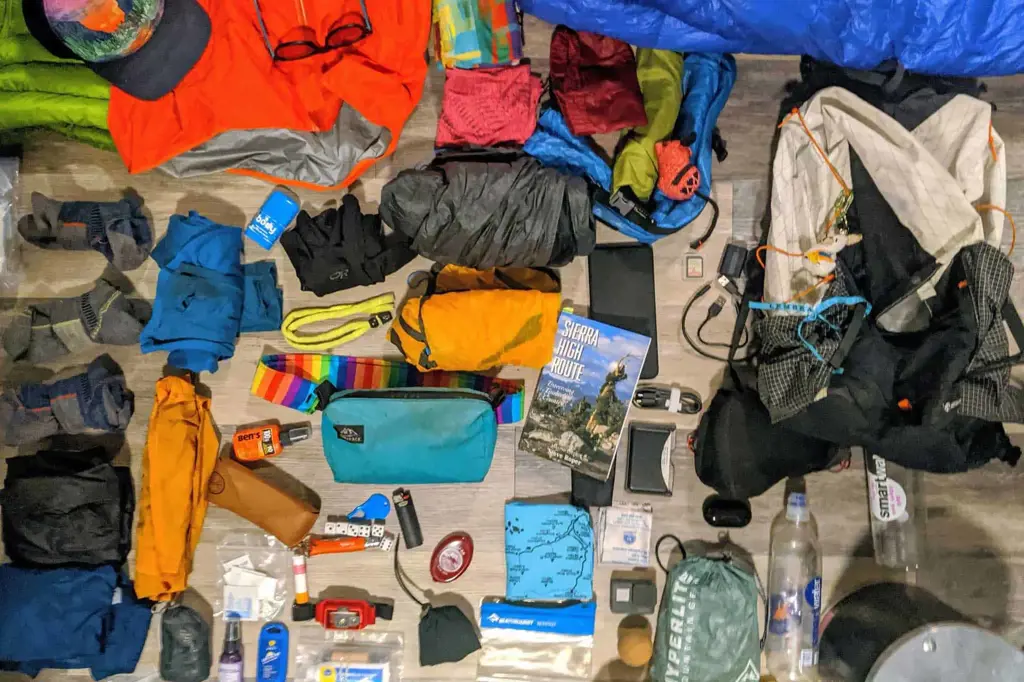
Hiking in the High Sierra is a breathtaking experience that offers stunning views and an opportunity to reconnect with nature. However, it is essential to be well-prepared and equipped for this challenging terrain. Here are some specific gear and equipment recommendations that will make your high sierra hiking adventure safer and more enjoyable.
- Backpack: Having a sturdy and comfortable backpack is crucial for carrying all your essentials. Look for a backpack with a capacity of around 50-70 liters, with adjustable straps and a supportive frame.
- Tent: Since you'll be camping during your hike, a reliable and lightweight tent is essential. Look for a tent that is easy to pitch and offers protection against the elements.
- Sleeping bag: The high sierra can get cold at night, even during the summer months. Invest in a high-quality sleeping bag that is suitable for the expected temperatures. Look for a bag with a temperature rating lower than what you anticipate encountering.
- Hiking boots: Invest in a good pair of hiking boots that provide ankle support and have a sturdy sole for traction on rocky terrain. Make sure to break them in before your trip to avoid blisters and discomfort.
- Clothing: Layering is key for high sierra hiking. Pack moisture-wicking base layers, insulating mid-layers, and a waterproof outer shell. Also, don't forget a hat, gloves, and a warm jacket.
- Navigation tools: The high sierra is an extensive wilderness area, and it's easy to get lost. Carry a map and a compass or a GPS device to navigate your way. Familiarize yourself with the area before your trip and have a backup plan if needed.
- Water filter: Since you'll be hiking for extended periods, it's essential to have a reliable water filter or purification system. The High Sierra has many natural water sources, and filtering your water will ensure it is safe to drink.
- Trekking poles: Trekking poles provide stability and help distribute weight, reducing the strain on your knees and ankles. They are particularly useful when hiking on steep ascents or descents and uneven terrain.
- First aid kit: Accidents can happen, even on well-maintained trails. Pack a first aid kit with essentials such as bandages, bug repellent, sunscreen, and any personal medications.
- Food: Carry enough food to sustain yourself throughout the duration of your hike. Look for lightweight, high-energy options such as granola bars, nuts, and dehydrated meals. Ensure you have a way to cook your food if necessary.
These are just a few recommendations to get you started on your high sierra hiking journey. It's essential to research the specific trail you'll be hiking and check for any additional gear requirements. Remember to always prioritize safety and be prepared for unexpected challenges. Happy hiking!
The Essential Items to Pack for Basic Training
You may want to see also

What types of snacks and meals are recommended for high sierra hikes to ensure energy and nutrition?
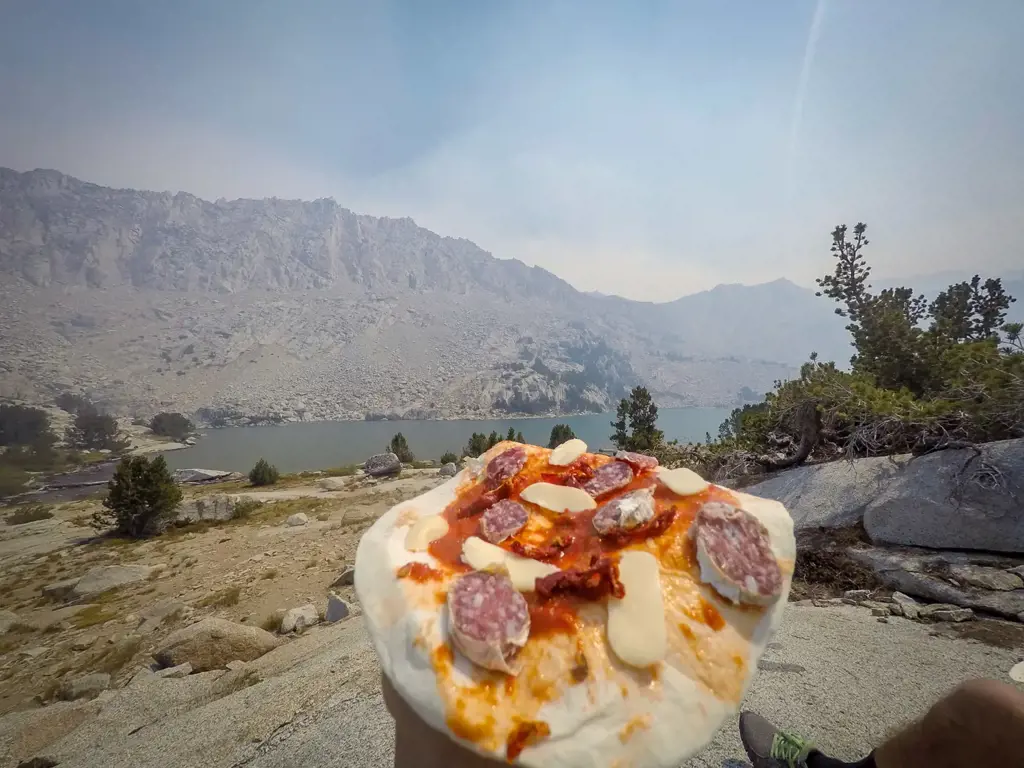
When embarking on a high Sierra hike, it is essential to plan your meals and snacks carefully to ensure you have enough energy and proper nutrition to sustain you throughout your journey. The high altitude and strenuous nature of these hikes require a balance of carbohydrates, protein, and healthy fats to keep you going. In this article, we will explore the types of snacks and meals that are recommended for high Sierra hikes to ensure optimal energy and nutrition.
- Carbohydrates: Carbohydrates are the primary source of energy during physical activities. They are quickly digested and converted into glucose, which fuels the muscles. Opt for complex carbohydrates such as whole grains, fruits, and starchy vegetables. Granola bars, trail mix with dried fruits, and energy gels are excellent options for quick energy boosts. These snacks are lightweight and can be easily carried in your backpack.
- Protein: Protein is crucial for muscle repair and recovery during long hikes. Including protein in your snacks and meals will help sustain your energy levels and prevent muscle breakdown. Look for snacks that contain nuts, seeds, or jerky. Nut butters, such as almond or peanut butter, are also convenient options to pair with fruits or crackers. For meals, consider packing dehydrated beans, tofu, or canned fish.
- Healthy Fats: Healthy fats provide a concentrated source of energy and help to maintain a feeling of satiety. They are essential for the absorption of fat-soluble vitamins. Nuts, seeds, avocados, and olives are excellent sources of healthy fats. Choose trail mix with a variety of nuts and seeds, or make your own energy bars using nut butter and coconut oil.
- Hydration: Staying hydrated is crucial during high Sierra hikes. Dehydration can lead to fatigue, muscle cramps, and impaired cognitive function. Carry a lightweight water bottle or hydration bladder and drink regularly throughout your hike. If you prefer flavored drinks, opt for electrolyte-rich beverages to replenish the minerals lost through sweating.
- Meal Planning: In addition to snacks, it is essential to plan your meals for longer hikes. Consider meals that can be easily prepared using a portable stove or cold meals that require minimal preparation. Dehydrated meals, instant rice or noodles, and lightweight canned foods, such as tuna or chicken, are popular choices among hikers. Pack a variety of meals to ensure you have a balanced diet and prevent food fatigue.
It is important to note that everyone's nutritional needs and preferences may vary. Before embarking on a high Sierra hike, consult with a nutritionist or dietitian to personalize your meal and snack plan based on your specific dietary requirements, activity level, and hiking duration.
In conclusion, selecting the right snacks and meals for high Sierra hikes is essential to ensure you have the energy and nutrition needed for these demanding treks. Remember to prioritize carbohydrates for quick energy, include protein for muscle repair, incorporate healthy fats for long-lasting energy, and stay adequately hydrated throughout your journey. Happy hiking!
5 Items You Should Leave Behind When Packing for a Carnival Cruise
You may want to see also

Are there any additional items or considerations that should be taken into account when packing for a high sierra hike, such as weather conditions or wildlife encounters?

When packing for a high sierra hike, there are several additional items and considerations that should be taken into account to ensure a safe and enjoyable experience. In the high sierra, weather conditions can change rapidly, and encounters with wildlife are also possible. Here, we will discuss some important items and considerations for a high sierra hike.
Weather conditions: The weather in the high sierra can be unpredictable, with sudden storms, high winds, and temperature fluctuations. It is essential to check the weather forecast before your hike and pack accordingly. Some key items to include in your pack are:
- Layered clothing: Bring clothing that can be layered to adjust to changing temperatures. This includes a wicking base layer, insulating mid-layer, and a waterproof and windproof outer layer. Make sure to pack a warm hat, gloves, and a rain jacket.
- Extra socks: Wet feet can lead to blisters and discomfort, so pack extra pairs of socks to keep your feet dry. Consider wearing moisture-wicking and quick-drying socks to prevent sweat buildup.
- Sleeping bag and tent: Depending on the length of your hike, you may need to carry a sleeping bag and tent. Look for a lightweight and compact sleeping bag that is suitable for the expected temperatures.
Wildlife encounters: The high sierra is home to various types of wildlife, including bears, mountain lions, and rattlesnakes. While encounters with these animals are rare, it is important to take precautions to ensure your safety. Here are some tips:
- Bear canister: Bears are attracted to food smells and can be aggressive if they come into contact with human food. Invest in a bear canister to store your food securely and keep it away from your sleeping area.
- Noise and awareness: Make noise while hiking to alert animals of your presence and to avoid surprising them. Keep your eyes and ears open, and be aware of your surroundings. If you encounter wildlife, remain calm, back away slowly, and do not turn your back on the animal.
- Snakebite kit: While the chances of encountering a rattlesnake are relatively low, it is a good idea to carry a snakebite kit, consisting of a suction pump and antivenom medications, if available.
Navigation and communication: The high sierra can present challenges in terms of navigation, especially if you are hiking off-trail or in unmarked areas. Consider the following:
- Map and compass: Carry a detailed map and compass and learn how to use them before your hike. GPS devices or smartphone apps with offline maps can also be helpful, but should not be relied upon solely.
- Personal locator beacon (PLB): A PLB is a small device that can send a distress signal with your GPS coordinates to emergency services in case of an emergency. Consider carrying one for added safety.
- Check-in with a friend: Before setting off on your hike, let someone know your itinerary, including your planned route and expected return date. Check in with them regularly to inform them of your progress.
In summary, when packing for a high sierra hike, it is important to consider the unpredictable weather conditions and potential wildlife encounters. By packing appropriate clothing, taking necessary precautions, and being prepared for any emergencies, you can ensure a safe and enjoyable hiking experience in the high sierra.
Essential Items to Pack for a Hostel Stay
You may want to see also
Frequently asked questions
When preparing for high Sierra hiking, it's important to pack essential items that will ensure your safety and comfort on the trail. These include a high-quality backpack, sturdy hiking boots, layered clothing for changing weather conditions, a first aid kit, a waterproof jacket, a hat and sunglasses for sun protection, a map and compass, a headlamp or flashlight, plenty of water and water purification tablets, high-energy snacks, a multi-tool or knife, sunscreen, and a lightweight backpacking stove for cooking meals.
Packing your backpack properly is crucial for a comfortable and efficient high Sierra hiking experience. Start by placing heavier items such as your sleeping bag and cooking gear at the bottom of your pack. Next, arrange your clothes in small, compact bundles and place them around the heavier items. Keep frequently-used items like your map, compass, and snacks easily accessible in outer pockets or the top of your pack. Make sure to distribute weight evenly so that your pack feels balanced while hiking. Lastly, use compression straps to secure and stabilize your load, and adjust the backpack's shoulder straps and hip belt for a comfortable fit.
When it comes to food and water, it's essential to plan for the duration of your high Sierra hike, as well as any potential delays or emergencies. As a general guideline, pack at least two liters of water per day per person. If you're hiking in dry conditions or at high elevation, you may need to increase this amount. It's also recommended to carry water purification tablets or a filtration system to replenish your water supply from natural sources along the trail. For food, choose lightweight, high-energy options like dehydrated meals, trail mix, energy bars, and instant oatmeal. Calculate the number of calories you'll need per day based on your activity level and pack enough food to meet those needs.







